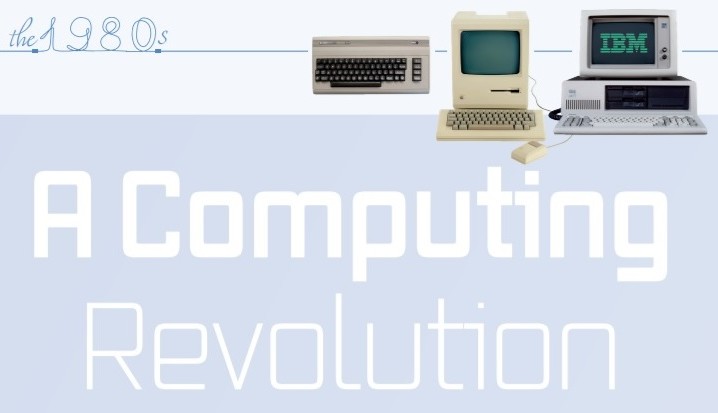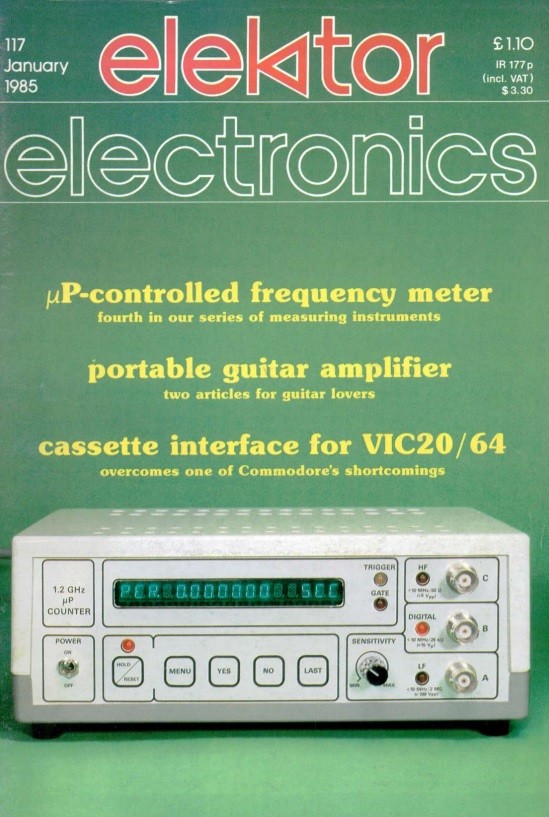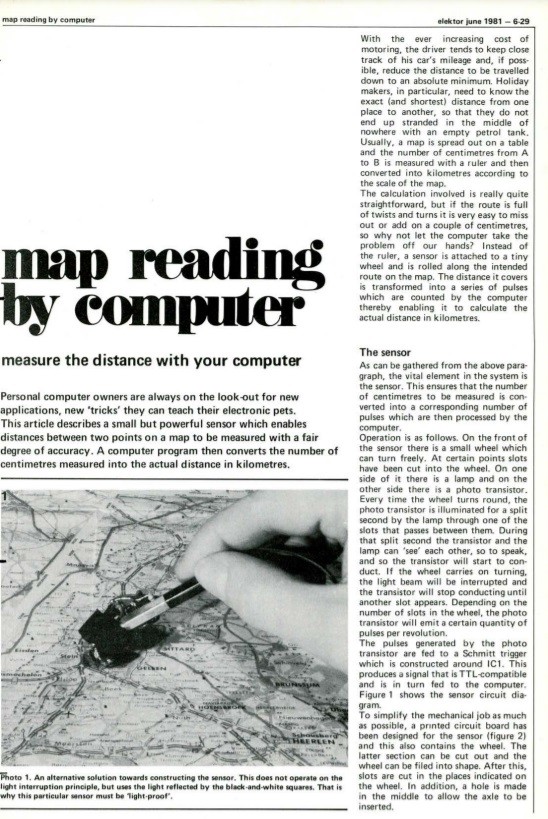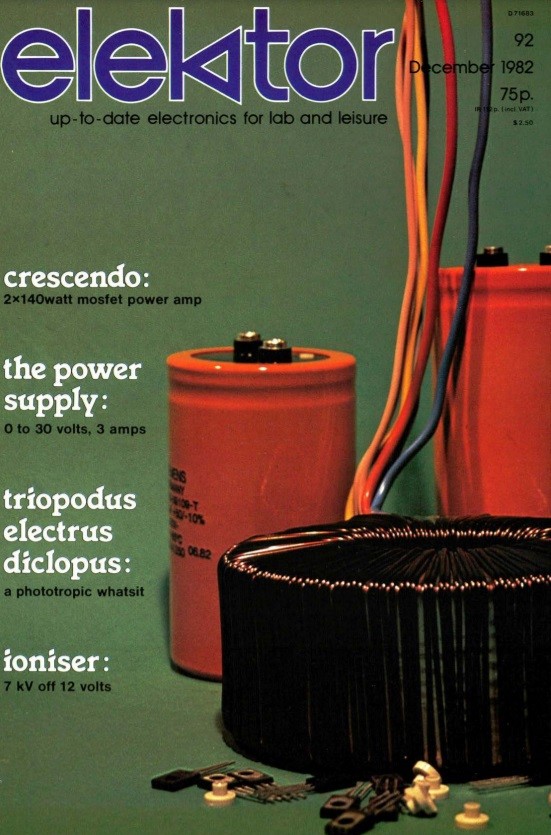The 1980s: A Computing Revolution
on

At the beginning of the 1980s, during which the computer became established, you still had to look hard to find one around you! Within a few years, electronics had become digital, and there was no longer any question of escaping the computer. There is no need to specify what is meant here by "Mr. Everyman" or by "computer" (Figure 1). Rather, it should be remembered that at the beginning of this period, screens — other than those on television sets — were still virtually non-existent in everyday life. Paper reigned supreme, as it had done since Gutenberg, both at home and at work. In fact, to symbolize a computer in 1980, strips of perforated paper were used! Remember, we communicated by fax, which had to be photocopied to keep them before they faded away!

Elektor Junior Computer!
This period of technological hustle and bustle is like the story of the chicken that found a knife: we didn’t know how it worked or what it would all be used for. Yet the French word informatique (coined in 1962) perfectly expressed the emerging vocation of the pandemonium of digital electronics: to process information.
Homo informaticus used electronics to forge new techniques for disseminating information at an extraordinary rate. In turn, these new techniques have changed our way of life. The beginnings of this change were felt long before, but now the shift became irreversible.
Homo informaticus
For each of these 10 years, here is one of those products whose innovative character has struck curious minds and opened up the consumer’s purse. The dates mentioned are indeed dates of commercialization. What these products have in common is that they are still in use today, either under their original name or in a derivative form. They have even become indispensable in the lives of most of us. A simple enumeration is sufficient:
- 1981: IBM PC MS-DOS
- 1982: Commodore 64
- 1983: Lotus 1-2-3
- 1984: Macintosh and the Mouse
- 1985: Nintendo Entertainment System
- 1986: Automated Listserv (First Email Service)
- 1987: Hypercard
- 1988: Photoshop
- 1989: First GPS Satellite | World Wide Web
- 1990: First Web Browser: Worldwideweb renamed Nexus
If some of these dates have surprised you, please check them.
Penury
The 1980s was also the decade of Ronald Reagan's presidency. It ended with the fall of the Berlin Wall (1989). Environmental disasters such as Bopal (1984) and Chernobyl (1986) cast a shadow over the harebrained technological triumphalism then in vogue. China was not yet making iPhones, but Deng was beginning to prepare them, in his own way (“Hit it hard!” was his motto). Who would have predicted then that, 40 years later, the world’s electronics engineers would be anxiously scanning the docks where Chinese container ships docked with their electronic components (or face masks), which could not be found anywhere else!
The difficulty of finding components, at least in Europe, is obviously not a new problem. If in the 1980s and 1990s Europe was still trying to make its mark in the technological race, it was in the USA and the Far East that many breakthroughs were made. One remembers the exotic “Made in...” stamp on innovative components (e.g., Taiwan, Philippines, Japan, Malaysia, etc.). However, neither transport nor production capacities were then what they are today. For the amateur, therefore, innovation was often synonymous with frustration.
Plethora
If Elektor magazine launched in 1961, it means that it was 20 years old in the early 1980s. The right age? In human terms, certainly. And for dealing with upheavals too. For the editors of a print magazine (in black and white!), these posed crucial questions. What course to follow? Electronics was going in all directions. For example, the one of the electronic games (who remembers the electronic games bubble and its bursting?). The automotive, audio and music, space, or even the medical and imaging sectors... It was necessary to maneuver. In fact, around 1981, Bob van der Horst, founder and editor-in-chief of Elektor magazine, launched a publication devoted to medical technology, a field whose strong growth potential he had perceived, just as he had foreseen 20 years earlier that of semiconductors.
This thematic and technical proliferation was reflected in the lab and editorial staff of Elektor by the (peaceful) coexistence of several chapels, without anyone on the reader’s side knowing who the author was. The rule in force at that time was that articles produced by Elektor employees were never signed. Only articles produced by authors outside the editorial office and outside the Elektor lab were signed by their author.
The 1980s: Let’s Hear the Music!
Looking through the issues from the first half of the 1980s, however, one is struck by the high proportion of music-related topics: the Formant modular analog synthesizer (Figure 2), published several years earlier, still features prominently in Elektor’s advertising of its books, circuit boards and front panels. Loads of them were sold. And then came a vocoder, a Clavitar and a Chorosynth and many other bugles. All this is still 100% analog, even the famous Curtis integrated circuits which again gave another Elektor synthesizer at the end of 1981. However, at the same time, digital projects entered the magazine's contents in force. In May 1980, the first article dedicated to the Junior Computer (Figure 1) is no less than 11 pages long. In the same issue, a superb double-page advertisement for the Sinclair ZX80, for the first time in four-color while the rest of the magazine was in black and white and would remain so for a long time.

Less than a year later, Elektor devoted a special section to 16-bit microcontrollers — no, they were called microprocessors, microcontrollers did not yet exist (Figure 3). And in the same issue, immediately after this impressive dossier, there was an article, probably the first, about the new Volvo humidity sensor, which then became famous. Its descendants can still be found today, among other things, in the microcontroller training kits. This mixture of genres is characteristic of Elektor’s summaries over the years. The menu often switches from one exotic vegetable to another, but the favorite food is obviously the chip.

Guessing Success Criteria
Although the project unfortunately did not live up to the expectations it raised, Elektor’s metal detector, published in November 1981, was, to everyone's surprise, one of the articles that made a huge splash. The tremors and aftershocks have been felt for years.
The passing of time forces us to question the criteria for success and the difficulty of guessing them. For example, today synthetic voices and speech recognition are commonplace. However, when it was released in December 1981, Elektor’s Talking board (Figure 4) did not arouse any enthusiasm. Between the two dates, 40 years of trial and error have resulted in Alexa, Siri and others (“OK Google”).

“provide a vocabulary of several hundred words for a microprocessor system!”
A striking point is the curious hiatus that sometimes exists between the cover and the content of the magazine: important articles are not mentioned at all on the cover, perhaps because at that time the cover (in color) was finished well before the rest of the magazine (in black and white). Did the editors doubt that this or that article would be ready in time? It may also reflect differences of opinion in the editorial staff and in the Elektor lab about what to put on the cover to attract the attention of the customers in the newsstands.
To illustrate and put this into perspective, Figure 5 is a counterexample of this observation, with an issue whose contents seem to me incredibly rich and ambitious, with the Artist (guitar preamp), an article on a Z80 µP card, another on the 6502-housekeeper project (home automation already), and the Polyformant (music always!), all mentioned on the cover.

Z80 µP-card, 6502-housekeeper project, and Polyformant (music again!),
all mentioned on the cover
Italy Already, but Without Arduino
Thanks to its English, German, Dutch and French language editions, Elektor was read all over the world. During the 1980s, Elektor enjoyed strong international growth with editions in other languages, including Italian, Spanish, and Swedish.

In the 1980s, licensed editions also existed in India, Pakistan, Indonesia, Brazil, and more. To illustrate this diversification, refer to Figure 6, which shows the cover of the Italian edition of Elektor in 1981. Italy, birthplace of the Arduino... One can speculate on what could have happened if Elektor and the Arduino had met and mated earlier. Ma questa è un'altra storia.
The Computing Revolution: A Salute to Outstanding 1980s Articles
Superlatives should be used sparingly when describing electronic equipment, but we think it is only natural to feel a certain amount of pride. This is a tribute to the Elektor designers who continually burned the midnight oil working on the design.

1.2 GHz Microprocessor-Controlled Frequency Counter
(Elektor, January 1985)
A do-it-yourself frequency meter whose capabilities, features, and ease of use are comparable to much more expensive ready-made (professional) equipment. If you are thinking of building or buying a new frequency counter, you should read this article and study the circuit diagram first. The chances are that this will be your next frequency meter.
Electronics in Cars
(Elektor April 1980)
Traditionally the theme of the April issue was automotive electronics. These issues, apart from the summer double issues, usually broke sales records. This is one of the best-sold issues of Elektor ever.
Gas Detector (Figaro)
(Elektor, September 1982)
Another huge hit. Quote: “Readers will be pleasantly surprised by the electronics in figure 1, or rather by the lack of them. As can be seen very few components are required.” The Figaro sensor from Japan used by this detector is a good example of those then new components that were in the spotlights but hard to find. Demand far outstripped supply. This article must have caused at least as much frustration as enthusiasm.

Map Reading by Computers
(Elektor June 1981)
Personal computer owners are always on the look-out for new applications, new “tricks” they can teach their electronic pets. This article describes a small but powerful sensor which enables distances between two points on a map to be measured with a fair degree of accuracy. A computer program then converts the number of centimeters measured into the actual distance in kilometers.
Fuel Consumption Meter
(Elektor April 1980)
The success with readers of automotive circuits was overwhelming in those days. Their two favorite topics were battery chargers of all kinds and fuel consumption circuits like this one.
Surface-Mount Devices
(Elektor December 1985)
If asked to guess when SMD were first discussed in Elektor, few normally informed readers would think it was back in 1985. Yet, even then, the subject raised many questions, some of them anxious. Many thought that soon no one would be able to solder components at home. They were not entirely wrong but would open their eyes wide if they saw the feats made possible by the availability of video tutorials on YouTube.

Crescendo 2 x 130 W MOSFET Stereo Power Amplifier
(Elektor December 1982)
This anthology of articles from the 1980s has only a limited ambition to represent these fertile years. Analog circuits were not left out, especially in the audio field. In their correspondence with elektor, even today, readers regularly mention their Crescendo amplifier, still in use. This is how it was proudly introduced then: “The start to our XL system. A high quality symmetric/complementary MOSFET stereo power amplifier easily delivering 140 W into 8 R. It is short circuit proof, includes speaker protection, power meters, temperature, and power-up indication. An amplifier which will leave any serious-minded audiophile speechless!” In a completely different vein, we note in the contents of this same issue the presence of an article that described an astonishing interface for floppy disks for the Junior Computer. For the reader of 2021 who doubted it, it worked very well!
This article about the computing revolution of the 1980s first appeared in the special November 2021 edition of Elektor. Previous editions of Elektor dating back to 1974 are available in the Elektor USB archive.


Discussion (0 comments)